R. Thukral
Padé Research Centre, 39 Deanswood Hill, Leeds, West Yorkshire, LS17 5JS, England
Correspondence to: R. Thukral, Padé Research Centre, 39 Deanswood Hill, Leeds, West Yorkshire, LS17 5JS, England.
| Email: |  |
Copyright © 2020 The Author(s). Published by Scientific & Academic Publishing.
This work is licensed under the Creative Commons Attribution International License (CC BY).
http://creativecommons.org/licenses/by/4.0/

Abstract
This paper presents new three-point Secant-type methods for finding simple root of nonlinear equations. It is proved that the new methods have the convergence order of 1.84 or 1.80 requiring only one function evaluations per full iteration. Some of the three-point Secant-type iterative methods are shown to have the same order of convergence as the Tiruneh et al. method, the Muller method and the Traub methods. Numerical comparisons are made to demonstrate exceptional convergence speed of the proposed methods. It is observed that the new three-point Secant-type iterative methods are very competitive with the similar robust methods.
Keywords:
Secant-type methods, Simple root, Nonlinear equations, Root-finding, Order of convergence
Cite this paper: R. Thukral, New Three-Point Secant-Type Methods for Solving Nonlinear Equations, American Journal of Computational and Applied Mathematics , Vol. 10 No. 1, 2020, pp. 15-20. doi: 10.5923/j.ajcam.20201001.03.
1. Introduction
The root-finding problem arises in a wide variety of practical applications in physics and engineering [2,3,8]. In this paper, we present new three-point Secant-type iterative methods to find a simple root of the nonlinear equation. It is well established that the multipoint root-solvers is of great practical importance since it overcomes theoretical limits of one-point methods concerning the convergence order and computational efficiency. Recently, some modifications of the Secant-type methods for simple root have been proposed and analysed [4-7]. Hence, the purpose of this paper is to show further development of the secant-type methods. The three-point Secant-type iterative methods are shown to have the same order of convergence as the Tiruneh et al. method [7], the Muller method [1] and the Traub methods [8]. In view of this fact, the proposed methods are significantly better when compared with the established methods. We have found that the efficiency index of new iterative methods has a better efficiency index than the classical Secant method.We consider two well-known iterative methods for finding simple root of nonlinear equations are namely, the classical secant method | (1) |
and the Tiruneh et al method, given by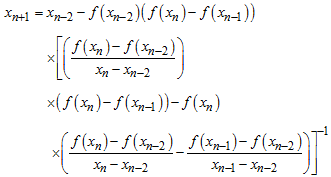 | (2) |
and their order of convergence is 1.62 and 1.84 respectively. However, for the purpose of this paper, we present a new three-point secant-type methods for finding simple root of nonlinear equations.The rest of the paper is organized as follows: Some essential definitions relevant to the present work are stated in the section 2. In section 3 we define some variants three-point secant-type methods and prove their order of convergence. In section 4, we will demonstrate the similarity between the Tiruneh et al. method and one of the proposed methods. Finally, in section 5, numerical comparisons are made to demonstrate the performance of the presented methods.
2. Preliminaries
In order to establish the order of convergence of an iterative method, following definitions are used [2,3,4,5,8,10].Definition 1 Let  be a real-valued function with a root
be a real-valued function with a root  and let
and let  be a sequence of real numbers that converge towards
be a sequence of real numbers that converge towards  . The order of convergence p is given by
. The order of convergence p is given by | (3) |
where  and
and  is the asymptotic error constant.Definition 2 Let
is the asymptotic error constant.Definition 2 Let  be the error in the kth iteration, then the relation
be the error in the kth iteration, then the relation | (4) |
is the error equation. If the error equation exists, then p is the order of convergence of the iterative method.Definition 3 Let  be the number of function evaluations of the method. The efficiency of the method is measured by the concept of efficiency index and defined as
be the number of function evaluations of the method. The efficiency of the method is measured by the concept of efficiency index and defined as | (5) |
where p is the order of convergence of the method.Definition 4 Suppose that  and
and  are three successive iterations closer to the root
are three successive iterations closer to the root  of a nonlinear equation. Then the computational order of convergence [10] may be approximated by
of a nonlinear equation. Then the computational order of convergence [10] may be approximated by  | (6) |
3. Derivation of the Methods and Convergence Analysis
In this section, we define new three-point secant-type iterative methods. These methods are of three different order of convergence. Before these new three-point secant-type iterative methods are stated we will denote the following,  | (7) |
 | (8) |
 | (9) |
 | (10) |
The first of the three-point Secant-type method is of order 1.62 and is expressed as | (11) |
The next two of the three-point Secant-type methods are of order 1.80 and they are expressed as | (12) |
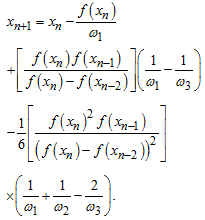 | (13) |
The rest of the three-point Secant-type methods are of order 1.84 and these are expressed as | (14) |
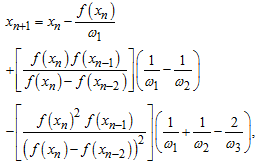 | (15) |
 | (16) |
 | (17) |
 | (18) |
 | (19) |
 | (20) |
where  are given by (7)-(10) respectively,
are given by (7)-(10) respectively,  are the initial values and provided that the denominators of (11)-(20) are not equal to zero. We emphasize that the formulas of (14), (18)-(20) are given in [8]. It is essential to verify our finding and prove the order of convergence of the new three-point secant-type iterative methods.Theorem 1Let
are the initial values and provided that the denominators of (11)-(20) are not equal to zero. We emphasize that the formulas of (14), (18)-(20) are given in [8]. It is essential to verify our finding and prove the order of convergence of the new three-point secant-type iterative methods.Theorem 1Let be a sufficiently differentiable function and let for an open interval D has
be a sufficiently differentiable function and let for an open interval D has  be a simple zero of
be a simple zero of  in an open interval D, with
in an open interval D, with  in D. If the initial points
in D. If the initial points  are sufficiently close to
are sufficiently close to  then the asymptotic convergence order of the new methods defined by (16) is 1.84.Proof Let
then the asymptotic convergence order of the new methods defined by (16) is 1.84.Proof Let  be a simple root of
be a simple root of  , i.e.
, i.e.  and
and  , and the errors at
, and the errors at  and
and  iteration are expressed as
iteration are expressed as 

 and
and  respectively.Using Taylor expansion and taking into account that
respectively.Using Taylor expansion and taking into account that  we have
we have | (21) |
 | (22) |
 | (23) |
where  | (24) |
Using (21)-(23), we obtain  | (25) |
 | (26) |
 | (27) |
 | (28) |
Substituting the expressions (25)-(28) in (16), we obtain | (29) |
Simplifying, we obtain the error equation for the new three-point Secant-type iterative method, given by (16) is | (30) |
In order to prove the order of convergence of (16) and we defining positive real terms of  and
and  as
as | (31) |
The error terms of  are given as
are given as | (32) |
 | (33) |
 | (34) |
It is obtained from (30) that | (35) |
substituting the appropriate expressions of errors terms in (35), we get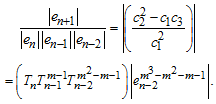 | (36) |
In order to satisfy the asymptotic equation (36), the power of the error term shall approach zero, that is | (37) |
The roots of the cubic equation (37) are; | (38) |
The order of convergence of the new three-point Secant-type method is determined by the positive root of (38). Hence, the new three-point Secant-type method defined by (16) has a convergence order of 1.84. This completes the proof.We repeat the procedure to prove the error equations for the other proposed three-point Secant-type methods.Theorem 2Let be a sufficiently differentiable function and let for an open interval D has
be a sufficiently differentiable function and let for an open interval D has  be a simple zero of
be a simple zero of  in an open interval D, with
in an open interval D, with  in D. If the initial points
in D. If the initial points  are sufficiently close to
are sufficiently close to  then the asymptotic convergence order of the new methods defined by (12) and (13) is 1.80.Similarly, we prove the order of convergence of (12) and (13) by similar procedure of the previous proof. Using (25)-(28) we get
then the asymptotic convergence order of the new methods defined by (12) and (13) is 1.80.Similarly, we prove the order of convergence of (12) and (13) by similar procedure of the previous proof. Using (25)-(28) we get | (39) |
substituting the appropriate expressions of errors terms in (39), we get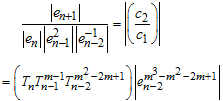 | (40) |
In order to satisfy the asymptotic equation (40), the power of the error term shall approach zero, that is | (41) |
The roots of the cubic equation (41) are; | (42) |
The order of convergence of the new three-point Secant-type methods is determined by the positive root of (41). Hence, the new three-point Secant-type methods defined by (12) and (13) has a convergence order of 1.80.It is elementary to prove the order of convergence of the new three-point Secant-type method given by (11). Using the similar procedure as above, the order of convergence order of (11) is 1.62.RemarkThe new three-point Secant-type iterative methods require single function evaluation and has the order of convergence 1.84 or 1.80. To determine the efficiency index of these new methods, definition 3 shall be used. Hence, the efficiency index of the new three-point Secant-type iterative methods is as their order of convergence.
4. Equivalence of the Approximation
In this section, we will demonstrate the similarity between the Tiruneh et al. (2) and the proposed method (16). First, we will simplify the Tiruneh et al. method,  | (43) |
and then demonstrate the similarity of these methods. In order to show the equivalency, we simply equate the two methods.Let (16) = (43), we have  | (44) |
Applying cross-multiplication rule to (44), we obtain | (45) |
Expanding (45), we have | (46) |
Further expansion of (46) yields | (47) |
Cancelling common factors, we obtain | (48) |
Simplifying, we get  | (49) |
Factorizing, | (50) |
Simplifying, we have  | (51) |
Replacing  we obtain
we obtain | (52) |
Further simplification yields | (53) |
Expanding (53), we have | (54) |
Cancelling common factors, we obtain | (55) |
Combining appropriate terms, we get  | (56) |
Substituting  given by (7)-(9), into (56), we have
given by (7)-(9), into (56), we have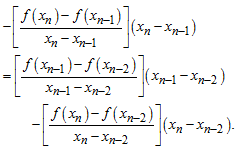 | (57) |
Again, cancelling common factors, we obtain | (58) |
Mathematically, we have demonstrated the fact that the (2) and (16) Secant-type methods produce equivalent results. Hence, the equation (58) establishes that the Tiruneh et al. method (2) and the new three-point Secant-type method (16) produce identical estimates of the simple root of the nonlinear equation. Furthermore, this is manifested in the numerical examples.
5. Numerical Test Results
The proposed three-point Secant-type iterative methods are employed to solve nonlinear equation with simple root. The difference between the simple root  and the approximation
and the approximation  for test function with initial guess
for test function with initial guess  is displayed in tables. Furthermore, the computational order of convergence approximations is displayed in tables and we observe that this perfectly coincides with the theoretical result. The numerical computations listed in the table was performed on an algebraic system called Maple and the errors displayed are of absolute value.Numerical example 1We will demonstrate the order of convergence of the new three-point Secant-type iterative methods for the following nonlinear equation
is displayed in tables. Furthermore, the computational order of convergence approximations is displayed in tables and we observe that this perfectly coincides with the theoretical result. The numerical computations listed in the table was performed on an algebraic system called Maple and the errors displayed are of absolute value.Numerical example 1We will demonstrate the order of convergence of the new three-point Secant-type iterative methods for the following nonlinear equation | (59) |
having the exact value of the simple root of (59) is  In Table 1 the errors obtained by the methods described are based on the initial points
In Table 1 the errors obtained by the methods described are based on the initial points 
Table 1. Errors occurring in the approximation of the simple root of (59)
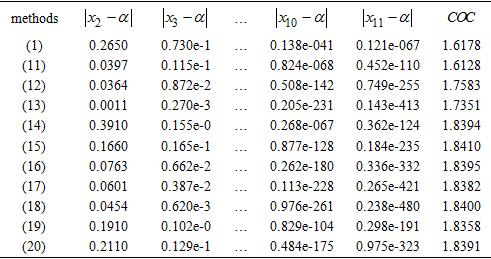 |
| |
|
Numerical example 2We will demonstrate the order of convergence of the new three-point Secant-type iterative methods for the following nonlinear equation | (60) |
having exact value of the simple root of (60) is  In Table 2 the errors obtained by the methods described are based on the initial points
In Table 2 the errors obtained by the methods described are based on the initial points 
Table 2. Errors occurring in the approximation of the simple root of (60)
 |
| |
|
Numerical example 3We will demonstrate the order of convergence of the new three-point Secant-type iterative methods for the following nonlinear equation | (61) |
having exact value of the simple root of (61) is  In Table 3 the errors obtained by the methods described are based on the initial guess
In Table 3 the errors obtained by the methods described are based on the initial guess 
Table 3. Errors occurring in the approximation of the simple root of (61)
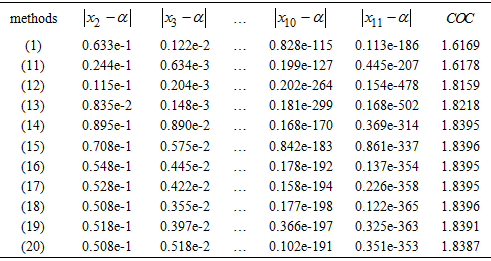 |
| |
|
6. Concluding Remarks
New three-point secant-type methods for solving nonlinear equations with simple root have been presented. The effectiveness of the new iterative methods is examined by showing the accuracy of the simple root of several nonlinear equations. Convergence analysis proves that the new three-point iterative methods preserve their order of convergence. Numerical examples are provided to support the theoretical results obtained and compared with different methods. The major advantages of the new three-point Secant-type methods are that they are very effective and produces high precision of approximation of the simple root and they are derivative-free. Finally, we conclude that the new three-point Secant-type iterative methods may be considered a very good alternative to the established methods.
References
| [1] | D. E. Muller, A method for solving algebraic equations using an automatic computer. Math. Tab. Comput. 10 (1956) 208-215. |
| [2] | A. M. Ostrowski, Solutions of equations and system of equations, Academic Press, New York, 1960. |
| [3] | M. S. Petkovic, B. Neta, L. D. Petkovic, J. Dzunic, Multipoint methods for solving nonlinear equations, Elsevier 2012. |
| [4] | R. Thukral, A new secant-type method for solving nonlinear equations, Amer. J. Comput. Appl. Math. 8 (2) (2018) 32-36. |
| [5] | R. Thukral, Further development of secant-type methods for solving nonlinear equations, Inter. J. Adv. J. Math. 38 (5) (2018) 45-53. |
| [6] | A.T. Tiruneh, W. N. Ndlela, S. J. Nkambule, A two-point Newton method suitable for non-convergent cases and with super-quadratic convergence, Adv. Numer. Anal. Art. ID 687382, (2013). |
| [7] | A.T. Tiruneh, T. Y. Debessai, G. C. Bwembya, S. J. Nkambule, A modified three-point secant method with improved rate and characteristics of convergence, Inter. J. Adv. Math. (4) (2019) 69-83. |
| [8] | J. F. Traub, Iterative Methods for solution of equations, Chelsea publishing company, New York 1977. |
| [9] | X. Wang, J. Kou, C. Gu, A new modified secant-like method for solving nonlinear equations, Comp. Math. Appl. 60 (2010) 1633-1638. |
| [10] | S. Weerakoon, T. G. I. Fernando, A variant of Newton’s method with accelerated third-order convergence, Appl. Math. Lett. 13 (2000) 87-93. |





 be a real-valued function with a root
be a real-valued function with a root  and let
and let  be a sequence of real numbers that converge towards
be a sequence of real numbers that converge towards  . The order of convergence p is given by
. The order of convergence p is given by
 and
and  is the asymptotic error constant.Definition 2 Let
is the asymptotic error constant.Definition 2 Let  be the error in the kth iteration, then the relation
be the error in the kth iteration, then the relation
 be the number of function evaluations of the method. The efficiency of the method is measured by the concept of efficiency index and defined as
be the number of function evaluations of the method. The efficiency of the method is measured by the concept of efficiency index and defined as
 and
and  are three successive iterations closer to the root
are three successive iterations closer to the root  of a nonlinear equation. Then the computational order of convergence [10] may be approximated by
of a nonlinear equation. Then the computational order of convergence [10] may be approximated by 














 are given by (7)-(10) respectively,
are given by (7)-(10) respectively,  are the initial values and provided that the denominators of (11)-(20) are not equal to zero. We emphasize that the formulas of (14), (18)-(20) are given in [8]. It is essential to verify our finding and prove the order of convergence of the new three-point secant-type iterative methods.Theorem 1Let
are the initial values and provided that the denominators of (11)-(20) are not equal to zero. We emphasize that the formulas of (14), (18)-(20) are given in [8]. It is essential to verify our finding and prove the order of convergence of the new three-point secant-type iterative methods.Theorem 1Let be a sufficiently differentiable function and let for an open interval D has
be a sufficiently differentiable function and let for an open interval D has  be a simple zero of
be a simple zero of  in an open interval D, with
in an open interval D, with  in D. If the initial points
in D. If the initial points  are sufficiently close to
are sufficiently close to  then the asymptotic convergence order of the new methods defined by (16) is 1.84.Proof Let
then the asymptotic convergence order of the new methods defined by (16) is 1.84.Proof Let  be a simple root of
be a simple root of  , i.e.
, i.e.  and
and  , and the errors at
, and the errors at  and
and  iteration are expressed as
iteration are expressed as 

 and
and  respectively.Using Taylor expansion and taking into account that
respectively.Using Taylor expansion and taking into account that  we have
we have









 and
and  as
as
 are given as
are given as






 be a sufficiently differentiable function and let for an open interval D has
be a sufficiently differentiable function and let for an open interval D has  be a simple zero of
be a simple zero of  in an open interval D, with
in an open interval D, with  in D. If the initial points
in D. If the initial points  are sufficiently close to
are sufficiently close to  then the asymptotic convergence order of the new methods defined by (12) and (13) is 1.80.Similarly, we prove the order of convergence of (12) and (13) by similar procedure of the previous proof. Using (25)-(28) we get
then the asymptotic convergence order of the new methods defined by (12) and (13) is 1.80.Similarly, we prove the order of convergence of (12) and (13) by similar procedure of the previous proof. Using (25)-(28) we get












 we obtain
we obtain




 given by (7)-(9), into (56), we have
given by (7)-(9), into (56), we have

 and the approximation
and the approximation  for test function with initial guess
for test function with initial guess  is displayed in tables. Furthermore, the computational order of convergence approximations is displayed in tables and we observe that this perfectly coincides with the theoretical result. The numerical computations listed in the table was performed on an algebraic system called Maple and the errors displayed are of absolute value.Numerical example 1We will demonstrate the order of convergence of the new three-point Secant-type iterative methods for the following nonlinear equation
is displayed in tables. Furthermore, the computational order of convergence approximations is displayed in tables and we observe that this perfectly coincides with the theoretical result. The numerical computations listed in the table was performed on an algebraic system called Maple and the errors displayed are of absolute value.Numerical example 1We will demonstrate the order of convergence of the new three-point Secant-type iterative methods for the following nonlinear equation
 In Table 1 the errors obtained by the methods described are based on the initial points
In Table 1 the errors obtained by the methods described are based on the initial points 

 In Table 2 the errors obtained by the methods described are based on the initial points
In Table 2 the errors obtained by the methods described are based on the initial points 

 In Table 3 the errors obtained by the methods described are based on the initial guess
In Table 3 the errors obtained by the methods described are based on the initial guess 
 Abstract
Abstract Reference
Reference Full-Text PDF
Full-Text PDF Full-text HTML
Full-text HTML

